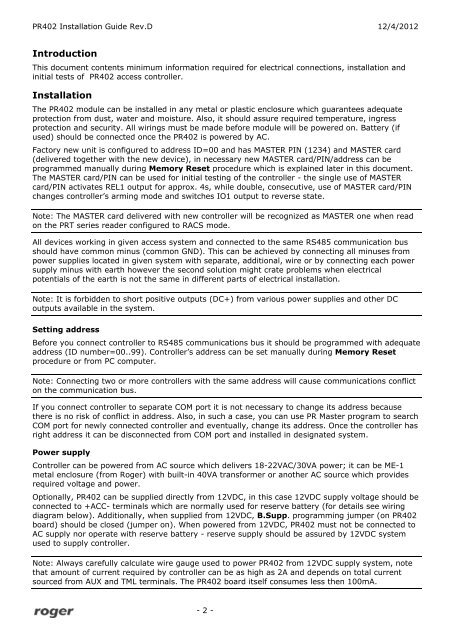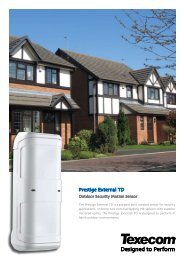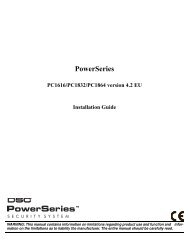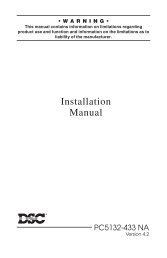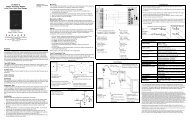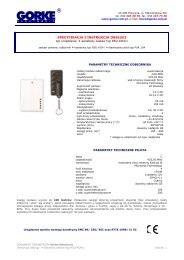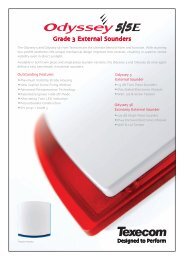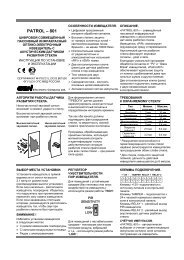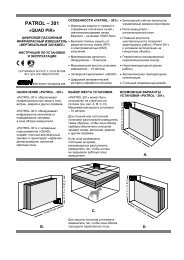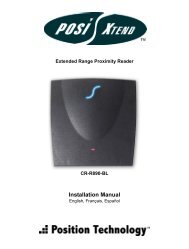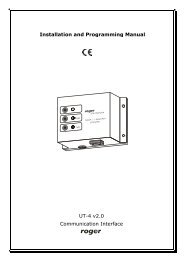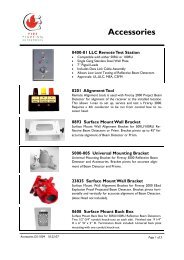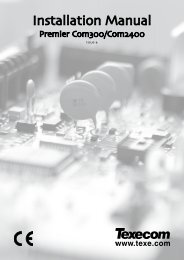PR402 Installation Guide Rev.D - Roger
PR402 Installation Guide Rev.D - Roger
PR402 Installation Guide Rev.D - Roger
You also want an ePaper? Increase the reach of your titles
YUMPU automatically turns print PDFs into web optimized ePapers that Google loves.
<strong>PR402</strong> <strong>Installation</strong> <strong>Guide</strong> <strong>Rev</strong>.D 12/4/2012IntroductionThis document contents minimum information required for electrical connections, installation andinitial tests of <strong>PR402</strong> access controller.<strong>Installation</strong>The <strong>PR402</strong> module can be installed in any metal or plastic enclosure which guarantees adequateprotection from dust, water and moisture. Also, it should assure required temperature, ingressprotection and security. All wirings must be made before module will be powered on. Battery (ifused) should be connected once the <strong>PR402</strong> is powered by AC.Factory new unit is configured to address ID=00 and has MASTER PIN (1234) and MASTER card(delivered together with the new device), in necessary new MASTER card/PIN/address can beprogrammed manually during Memory Reset procedure which is explained later in this document.The MASTER card/PIN can be used for initial testing of the controller - the single use of MASTERcard/PIN activates REL1 output for approx. 4s, while double, consecutive, use of MASTER card/PINchanges controller’s arming mode and switches IO1 output to reverse state.Note: The MASTER card delivered with new controller will be recognized as MASTER one when readon the PRT series reader configured to RACS mode.All devices working in given access system and connected to the same RS485 communication busshould have common minus (common GND). This can be achieved by connecting all minuses frompower supplies located in given system with separate, additional, wire or by connecting each powersupply minus with earth however the second solution might crate problems when electricalpotentials of the earth is not the same in different parts of electrical installation.Note: It is forbidden to short positive outputs (DC+) from various power supplies and other DCoutputs available in the system.Setting addressBefore you connect controller to RS485 communications bus it should be programmed with adequateaddress (ID number=00..99). Controller’s address can be set manually during Memory Resetprocedure or from PC computer.Note: Connecting two or more controllers with the same address will cause communications conflicton the communication bus.If you connect controller to separate COM port it is not necessary to change its address becausethere is no risk of conflict in address. Also, in such a case, you can use PR Master program to searchCOM port for newly connected controller and eventually, change its address. Once the controller hasright address it can be disconnected from COM port and installed in designated system.Power supplyController can be powered from AC source which delivers 18-22VAC/30VA power; it can be ME-1metal enclosure (from <strong>Roger</strong>) with built-in 40VA transformer or another AC source which providesrequired voltage and power.Optionally, <strong>PR402</strong> can be supplied directly from 12VDC, in this case 12VDC supply voltage should beconnected to +ACC- terminals which are normally used for reserve battery (for details see wiringdiagram below). Additionally, when supplied from 12VDC, B.Supp. programming jumper (on <strong>PR402</strong>board) should be closed (jumper on). When powered from 12VDC, <strong>PR402</strong> must not be connected toAC supply nor operate with reserve battery - reserve supply should be assured by 12VDC systemused to supply controller.Note: Always carefully calculate wire gauge used to power <strong>PR402</strong> from 12VDC supply system, notethat amount of current required by controller can be as high as 2A and depends on total currentsourced from AUX and TML terminals. The <strong>PR402</strong> board itself consumes less then 100mA.- 2 -


